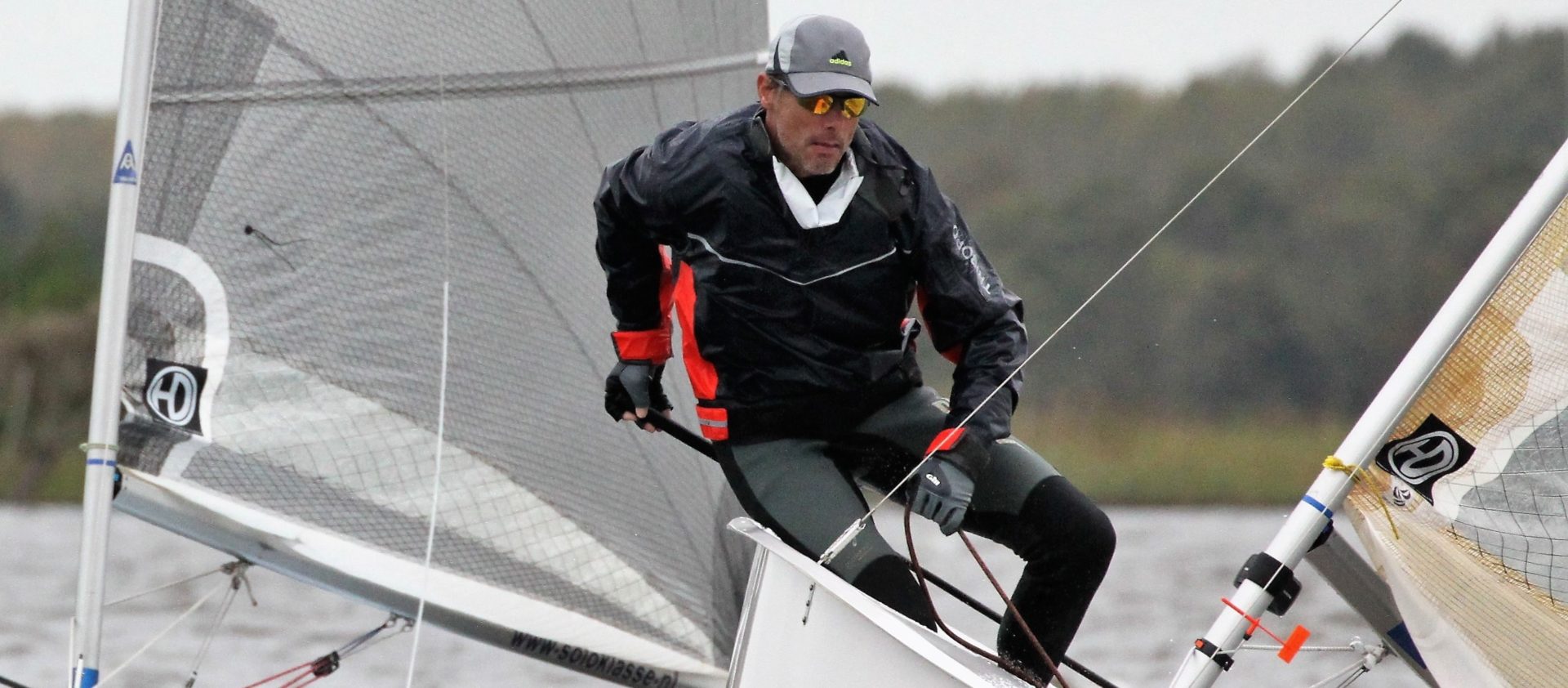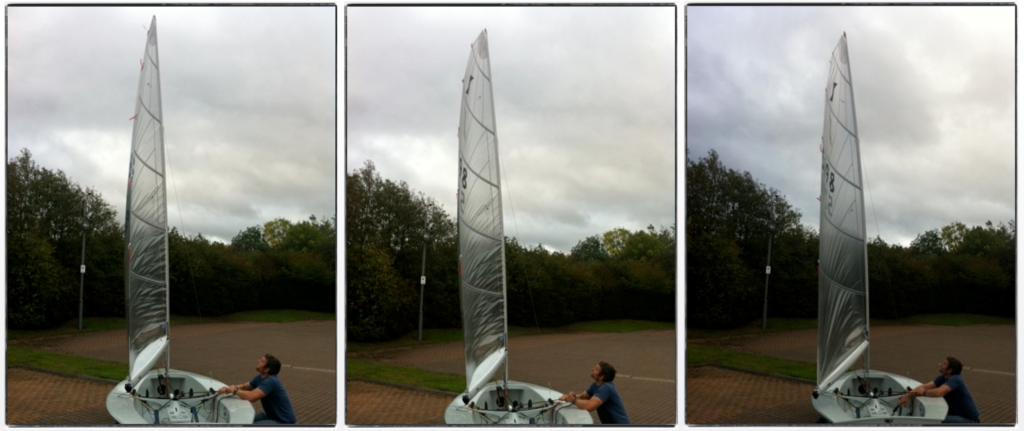Just after the Dutch Championship it is time for me to reflect on my last year. As it was a bit of struggle I think it is interesting for you guys to read. I switched from boat last year and it was quit a journey to be on the point where I am now. As you might know, only change one thing at the time, else you don’t know what causes the improvement. As I changed two things at the same time (boat and sail) it took me quit some time to figure out what was happening. Eventually I figured out that the most dramatic change was the sail. The HD max gold is not a standard sail and after last weekend I think I begin to understand both the sail as well as the sailmakers intention. So let me take you on that journey. On a side note, I am writing this article in English as my intention is to share it with the sail maker. I hope he can give some feedback and hope he has some answers to my outstanding questions. As a spoiler! Read the tuning guide [1] before anything as that was my main mistake. okay, lets kick off.
My New Boat
Ever since I have been sailing the solo I have an eye for the Boon solo. The more allround nature, better upwind capabilities the underdog position of the Boon hull where attracting me. Currently I was sailing a Winder Mk1 with a D+ mast and a North 3DL. A good combination but I felt more up to date material would do me good. When Ovington bought the Boon hulls and started building very high quality boats I decided to go for it. Just before the Dutch Championship of 2017 in Workum Kevan Gibb (currently sailing the 5803) offered his Ovington for sail (:-) sale). I made a downpayment and Kevan arranged for Patrick Burns and Chris Brown to deliver the solo. At the Dutch ONK a brand new solo was waiting for me in Workum. That was where my journey begins.
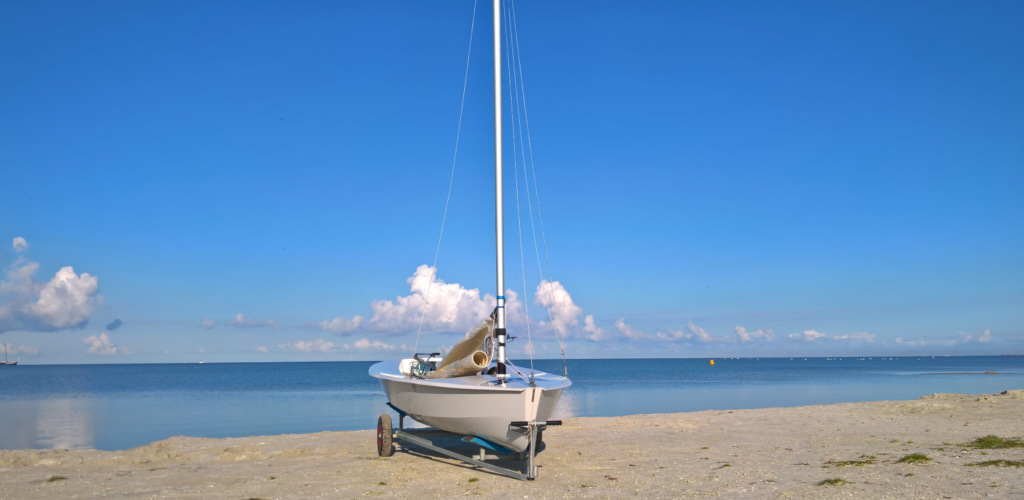
Picture 1: my brand new solo waiting on the Workum beach for the first day of sailing.
The boat came with everything you can wish for. Harken fittings, d-plus mast and an HD-sail. You have to get used to your new outfit and I knew the dutch championship would not be a walk in the park. Although I knew I was not a happy camper after my first two races. A 20-th and 23-rd place. The Sneekweek had more or less the same conditions and I had won that event quit convincingly. Now I was at 20-the place, what was going on? My boat speed was more or less okay (not convincingly), but the most disappointing was the pointing ability (dutch: hoogte lopen) on the upwind legs. What!!! I bought a brand new boat known for it’s upwind abilities (although more in the rough) and I was only lossing places. The next few races in 2017 where not getting any better. Top 10 was very hard to achieve. I had some good individual races mainly based on tactics but I was loosing it big time compared to my Winder Mk1. The basics where not okay, boatspeed and pointing ability where still not getting better.
Sneek Training Weekend (05/2018)
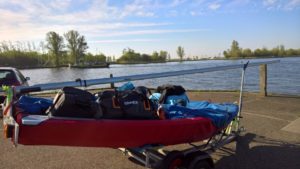
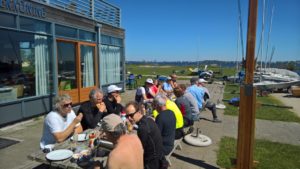
Picture 2: Trainingsweekend @Sneek
2018 started with a trainingsweekend at Sneek. The trainingsweekend brought me two great gifts. Jan Arends and the video crew arranged by Marc Dieben (those guys make the Solo sparkle!). Let me explain. We were training together on boat speed and pointing ability and both where still lacking (hey what’s new). Then Jan was sailing behind me. There was hardly any wind and Jan told me to pull the kicker (neerhouder), so I pulled the kicker a bit. “No”, directed Jan, “Pull it more”, so I pulled I bit more. This was feeling very weird, almost no wind and I was pulling the kicker as if it was gale force wind (stormkracht wind). Jan still wasn’t satisified, “pull it until I say stop!”. So I had to pull the kicker at least the same amount as I already pulled it????? No way, Jan was going mad. But the strange thing is. It was working. The pointing ability was better then Saskia (sneekweek winner 2018) and I was at least as fast as her. Jan told me the HD sail was cut with a very open leech (achterlijk) which required a lot of kicker to shape the sail into a decent foil with which you can sail.
I still couldn’t see what was the change in my sail, but I new exactly what to do. There was an excellent video crew on site, arranged by Marc Dieben, and I asked them to make a video of me pulling the kicker on. Once they sailed behind me they started the video and told me to go for it. I pulled the kicker and below the video. Watch the top of the sail closes as I pull the kicker.
Video 1: pulling the kicker on (1 second – sail is open, 2 seconds – halfway, 3 seconds – kicker is on)
The trainingsweekend was one of the most useful experiences of my solo sailing career. Before the weekend I was “Unconscious incompetent” (onbewust onbekwaam) and after the weekend I was “conscious incompetent” (bewust onbekwaam) according to the four stages of competence [3]. Why incompetent? I am sailing a lot faster, but no clue how to do this on my own. I could figure out why this new kicker setting has better pointing abilities, but I couldn’t figure out why the sail worked this way. This made me just a copy cat, repeating everything without any reasoning or own decision making.

Picture 3: The kicker effect. You can clearly see the difference in sail shape. Left, kicker off. Right, kicker on
- Learning 1: Kicker on, tightens the leech (achterlijk) and gives better pointing abilities
The Pay-Off: ONK Sprint
So with my newly learned ability I started the season of 2018. Only one question bothering me, hard kicker on with light winds was completely against everything I learned. But hey, I could sail a lot faster than at the beginning of the season, so why bother. The Tuesday evening matches where successful, I started out with a first place! So full confidence I went to the Dutch Championship sprint and it was a big success. The conditions where exactly matching those during the training in Sneek. So I applied my new learning. Kicker on (do not forget to loosen during tacking :-)) and I was going like a mad man. First places where falling regularly (we raced in groups of 10).
results: https://soloklasse.nl/evenement/onk-sprintwedstrijden/#uitslagen [4]
report: https://soloklasse.nl/evenement/onk-sprintwedstrijden/#wedstrijdverslag [4]
This was a very welcome result. My boat is ok, my sail is ok and my sailing capabilities are ok. After doing a short analysis off the race concerning boat handling I observed the following:
- Very Light conditions where extremely good.
- Upwind: Boat speed was on par with the Sirp-Jan / Peerke. Pointing ability was good
- Downwind: Boat speed maybe a bit lacking
- Light to moderate conditions where not as it should be
- Upwind: Boat speed was lacking with the top, on par with the sub-top. Pointing ability was good
- Downwind: Boat speed may be a bit lacking
There is one thing I need to figure out. How can I get enough boat speed in other conditions then those at Sneek. At this moment I was just a monkey repeating everything Jan told me.
How to find speed
After the ONK and the Braassem Summer Regatta (which was also good) it was time for a really big holiday. As I had plenty of time I decided to go and browse the interwebs for some speed. There I found a part of the answer. An excellent video from one of the heroes of the sailing class, Charlie Cumbley
Video 2: Charley Cumbley talking about Powering the sail using the Outhaul (onderlijk spanner) [5}
The main thing I got from this video is that most of your speed tuning is done using the Outhaul (onderlijk spanner). Pulling the outhaul flattens the sail from the bottom up (the largest part of your sail) and increases your speed. You can compare this effect with the gears in your car. First gear gives you a lot of power. You can pull big loads, but driving more than 40 is going to be very hard. On the other hand is your 6-th gear in which you can drive 200 but you cannot pull away from the traffic light. This basically explains the outhaul. A loose outhaul means a curved sail (1-st gear) with a lot of power. A flat sail is less power enabling for higher speeds (6-th gear). A Curved sail has a lot of drag (weerstand) with the wind having difficulties to flow through and gives you a big pulling force. This power is ideal for coming of the start-line, higher pointing or working through the waves.
- Learning 2: More outhaul tension is more speed
Finding the last piece: the Dutch Championships 2018
So there I was. I had my pointing ability gained from the training week. I had me speed ability gained from a really big holiday, so I should be up for the Dutch Championship. For me there where actually two championships needed to fill in the gaps in my brain. The ONK for the OK-dinghy and my own ONK for the Solo dinghy. Lets start with the Ok-dingy. That was a bit time learning experience for me. First time in the OK and maybe one of the first times in a dinghy with a free standing mast, so no shrouds (geen verstaging). This boat had the same sailmaker as my Solo (hey, thats cool!). Here was an opportunity to learn something. Fortunately I had another Jan, called Harm de Vries, shouting at me. This time not to pull on the kicker but to pull on the main sheet. Harm explained during a nice cold bear that the free standing mast always bends. The more wind, the more it bends, which is one of the big plusses of this type of mast. The bending means the sail can de-power (druk kwijtraken) very easily. The sail maker knows this behaviour and cuts the sail towards that flexible mast. Meaning that the sail has a lot of shape and with no pressure applied is almost like a teabag, with way too much curve (hey! that sounds familiar) and a top flying out (Hey, that was my problem with the solo!).
- By pulling the main sheet
- you tension the leech (achterlijk)
- which also pulls on the mast
- which makes a bend in the middle of the mast
The effect is that the sail is flattened by that curved mast, so no more teabag but a nice curved sail
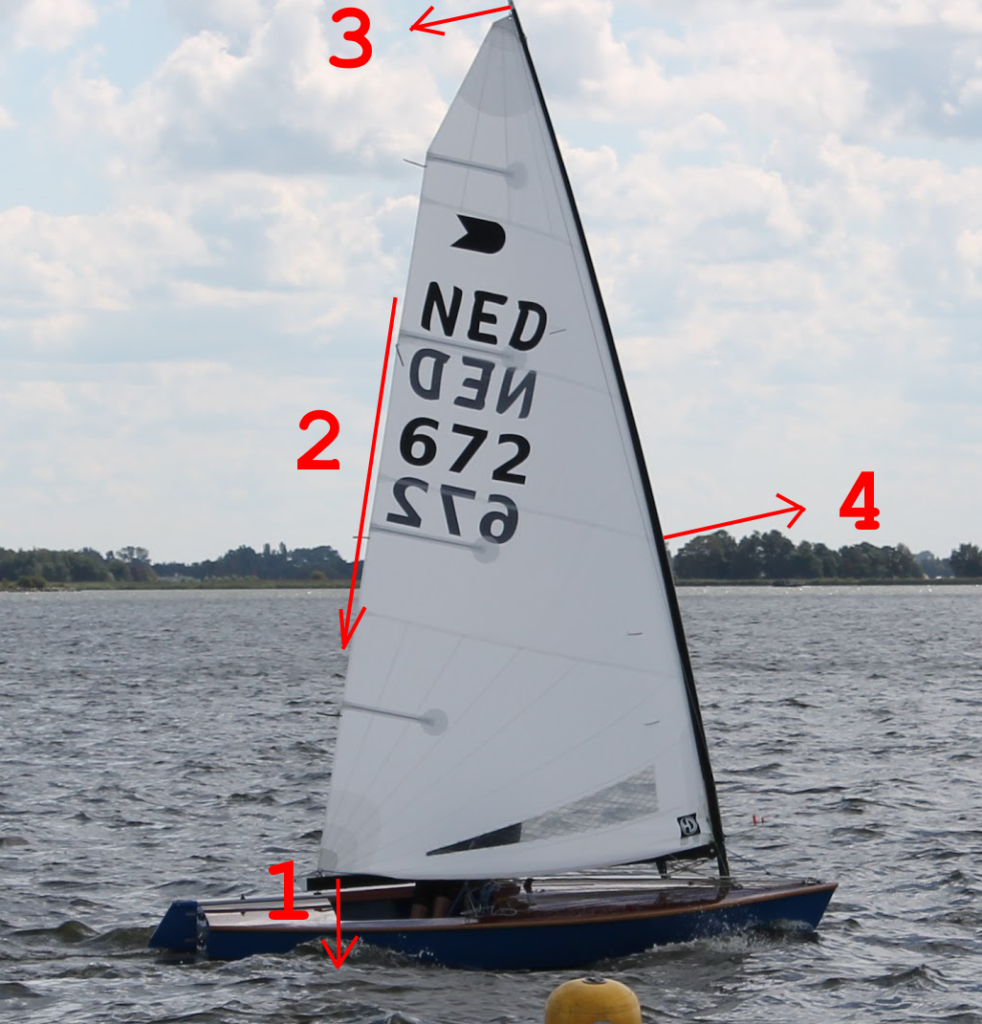
Picture 4: The effect of pulling the main sheet.
The next morning I applied some of the learnings. I managed to sail second around the first upwind mark and as I hadn’t screwed up the last upwind leg I could have finished on a fifth place. This was a match in which my boatspeed was on par with the top of the fleet as well as my pointing.
So fast forwarding to the ONK for the Solo. There was still a piece missing. I had learned a lot about the theory of the Ok-dinghy but I did not apply that theory on my own HD-gold sail. I needed a talk with Pim van Vught and Hedzer Dijkstra to finally clear up the last pieces. The championship was running more or less allright, but I was not very convinced of my performance. The rough conditions with strong winds was my strong point, both boat speed and pointing. Again the moderate conditions where failing and failing mostly on boat speed. Pim also wasn’t very convinced on his boat speed. On a side note: His boat is having the exact same sail as mine. As we were talking Pim pointed out that his boat speed was on par with the sub-top but lacking compared to the boat speed of Pete Mitchell. He was using a lot of kicker but couldn’t figure out how to get that extra bit of speed. Then Hedzer (I owe you one) pointed out to the HD sailing guide [1]. Basically what the tuning guid said was:
- Light conditions: lots of kicker, no Cunningham, outhaul tight, mainsheet tension
- Moderate conditions: no kicker, no Cunningham, more slack on the outhaul, more mainsheet tension
- Strong conditions: Lots and lots of kicker, hard on the cunnigham, outhaul tight and little mainsheet tension
Picture 5: Trimming pictures from the HD Sails tuning guide [1], left: trim for light conditions, center: trim for medium conditions, and right: trim for strong wind conditions
And that let me to search further for the reasoning behind that kicker on. Jim Hunt wrote a nice article [6] on his thoughts and experiments when designing and building the sail. He basically wants to mimic the behavior of the free standing mast like the Finn (his inspiration) but also the Ok-dinghy. He wants to have a sail which “Auto tunes” itself together with the mast when sailing. This means he wants a sail which de-powers during gusts (but holds its shape) and tightens during less wind. You basically need your kicker to remove the teabag from the sail and flatten it. So my main problem was that I did not understand the second usage of the kicker bending the mast (on purpose).
Learning 3: The kicker bends the lower part of the mast, flattening the sail and bringing the curve backwards.
Putting it all together
Let me try putting is all together without copying the Tuning guide [1]. The Tuning guide is lacking the explanation of why you are pulling the ropes in you boat, so let me try to that. I make the same division in wind:
- Light conditions:
This is the part I found hard to grab. Why to pull the kicker. The sail is build so full of shape and twist that it is like a teabag. Without pulling the ropes you will have way too much shape and loose both speed and pointing abilities. Ref. Picture 6: middle shows you a good indication of how much kicker to put on (NOTE: it is a serious amount of kicker, you will have troubles tacking with the kicker on). The reason the sail gets flat is because the kicker both pulls the boom (giek) down and forward. That forward force bends the lower part of the mast. The downward force tightens the leech (achterlijk). You also have to pull the outhaul (onderlijk) to flatten the lower part of the sail.1) the flattened sail gives you a less powerful sail with more speed potential.
2) the tight leech (achterlijk) gives you less twist and a better wing, more suited for pointing (hoogte lopen)
NOTE: do not pull the main sheet (grootschoot) to tight in order to keep the wind flowing - Medium conditions:
Still a territory I am discovering. Again you need to pull some ropes as your sail has again too much shape. You don’t touch the kicker but use your main sheet. Using the main sheet will tighten the leech (same as the kicker) but prevents the lower part of the mast to bend. The mast will bend with less radius giving the sail more shape. (NOTE: you will need your traveller out to leeward in order to pull the boom down without closing the sail too much. The boom is on the same height as with your kicker on. Again a position you might find difficult to tack with the main sheet on)1) the more curved sail gives you more power to work through the waves
2) the less bend will cause more twist in the sail (the upper part is more open) - Heavy conditions:
We are reverting back to the light conditions trim but we do need the twist of the medium conditions. This is where the Cunningham kicks in. We will pull on the kicker hard (Picture 6: right). As the kicker closes the sail to much we will use the Cunningham. Lots of cunningham will bend the mast more. More bend will give you the twist again. I wrap the Cunningham twice around my hand in order to pull it with all my weight. This will also bring the curve of sail more forward usefull for power through the waves (together with your outhaul).
1) flat sail to loose power and have less drag
2) use mostly the lower part of the sail (more twist)
NOTE: you can use less outhaul tension to get more power through the waves.

Picture 6: Amount of kicker to pull, left: kicker off, middle: kicker on light conditions, right: kicker full on, heavy conditions
Conclusion
Thanks all for hanging in till the end. It is quite a read. Let me tell you first to keep thinking for yourself. This article is just another opinion of a guy sailing the solo. I am trying to figure out stuff. When putting all the pieces together this was what I came up with and what seems to be working for me. All reference documents tell the same story so I think I am not lying :-). The main learning point for myself is to try and figure out what the sailmaker intentions where. The Tuning Guide [1] together with the blog post from Jim Hunt / Any Davis [6] are the first place to go to, which I obviously didn’t. Nevertheless I don’t think I would get the point if I read it the first time around. So for all you guys, keep tweeking the Solo and remember, only change one thing at the time to really know what made the difference.
links:
- [1] HD Sails tuning guide: http://www.hdsails.com/blog/wp-content/uploads/2012/02/Solo_Tuning_Guide.pdf
- [2] Results Open Dutch Championship 2017 http://oud.soloklasse.nl/news.php?id=654
- [3] Four stages of competence
- [4] Results Open Dutch Championship Sprint 2018: https://soloklasse.nl/evenement/onk-sprintwedstrijden
- [5] Tuning video Charlie Cumbley: https://youtu.be/HZFjsbEZgEQ?t=6m29s
- [6] Jim Hunts / Andy Davis blog post, the reasoning behind the HD Max gold sail: http://www.hdsails.com/home/golden-solo-sail
List of terms / lijst met betekenissen:
- Kicker ==> Neerhouder
- Outhaul ==> Onderlijk spanner
- Cunningham ==> voorlijk spanner
- Pointing ==> Hoogte houden (kruisrak)
- Leech ==> achterlijk
- Shroud ==> verstaging
- Boom ==> giek
- Main Sheet ==> grootschoot
- Gale force wind ==> storm
- Drag ==> weerstand
- De-Power ==> druk kwijtraken
- Leeward ==> naar lei (loef en lei)

